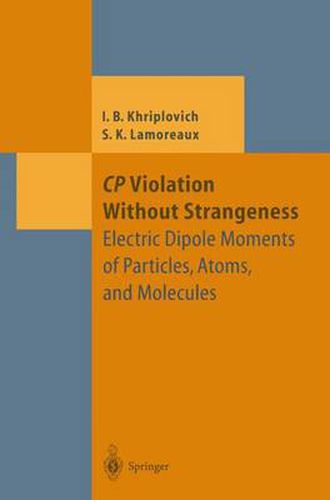Readings Newsletter
Become a Readings Member to make your shopping experience even easier.
Sign in or sign up for free!
You’re not far away from qualifying for FREE standard shipping within Australia
You’ve qualified for FREE standard shipping within Australia
The cart is loading…






This title is printed to order. This book may have been self-published. If so, we cannot guarantee the quality of the content. In the main most books will have gone through the editing process however some may not. We therefore suggest that you be aware of this before ordering this book. If in doubt check either the author or publisher’s details as we are unable to accept any returns unless they are faulty. Please contact us if you have any questions.
Electric dipole moments (EDMs) have interested physicists since 1950, when it was first suggested that there was no experimental evidence that nuclear forces are symmetric under parity (P) transformation. This question was regarded as speculative because the existence of an EDM, in addition to P violation, requires a violation of time-reversal (T) symmetry. In 1964 it was discovered that the invariance under CP transformation, which combines charge conjugation © with parity, is violated in K-meson decays. This provided a new incentive for EDM searches. Since the combined operations of CPT are expected to leave a system invariant, breakdown of CP invariance should be accompanied by a violation of time-reversal symmetry. Thus there is a reason to expect that EDMs should exist at some level. The original neutron EDM experiments were later supplemented with checks of T invariance in atoms and molecules. These investigations are pursued now by many groups. Over the years, the upper limit on the neutron EDM has been improved by seven orders of magnitude, and the upper limit on the electron EDM obtained in atomic experiments is even more strict.
$9.00 standard shipping within Australia
FREE standard shipping within Australia for orders over $100.00
Express & International shipping calculated at checkout
This title is printed to order. This book may have been self-published. If so, we cannot guarantee the quality of the content. In the main most books will have gone through the editing process however some may not. We therefore suggest that you be aware of this before ordering this book. If in doubt check either the author or publisher’s details as we are unable to accept any returns unless they are faulty. Please contact us if you have any questions.
Electric dipole moments (EDMs) have interested physicists since 1950, when it was first suggested that there was no experimental evidence that nuclear forces are symmetric under parity (P) transformation. This question was regarded as speculative because the existence of an EDM, in addition to P violation, requires a violation of time-reversal (T) symmetry. In 1964 it was discovered that the invariance under CP transformation, which combines charge conjugation © with parity, is violated in K-meson decays. This provided a new incentive for EDM searches. Since the combined operations of CPT are expected to leave a system invariant, breakdown of CP invariance should be accompanied by a violation of time-reversal symmetry. Thus there is a reason to expect that EDMs should exist at some level. The original neutron EDM experiments were later supplemented with checks of T invariance in atoms and molecules. These investigations are pursued now by many groups. Over the years, the upper limit on the neutron EDM has been improved by seven orders of magnitude, and the upper limit on the electron EDM obtained in atomic experiments is even more strict.